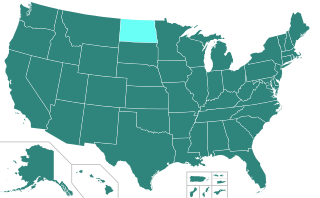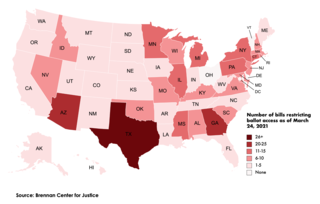
Elections in the United States are held for government officials at the federal, state, and local levels. At the federal level, the nation's head of state, the president, is elected indirectly by the people of each state, through an Electoral College. Today, these electors almost always vote with the popular vote of their state. All members of the federal legislature, the Congress, are directly elected by the people of each state. There are many elected offices at state level, each state having at least an elective governor and legislature. There are also elected offices at the local level, in counties, cities, towns, townships, boroughs, and villages; as well as for special districts and school districts which may transcend county and municipal boundaries.
In electoral systems, voter registration is the requirement that a person otherwise eligible to vote must register on an electoral roll, which is usually a prerequisite for being entitled or permitted to vote.

Election Day in the United States is the annual day for general elections of federal public officials. It is statutorily set by the U.S. government as "the Tuesday next after the first Monday in November", i.e. the Tuesday that occurs within November 2 to November 8.
An absentee ballot is a vote cast by someone who is unable or unwilling to attend the official polling station to which the voter is normally allocated. Methods include voting at a different location, postal voting, proxy voting and online voting. Increasing the ease of access to absentee ballots is seen by many as one way to improve voter turnout through convenience voting, though some countries require that a valid reason, such as infirmity or travel, be given before a voter can participate in an absentee ballot. Early voting overlaps with absentee voting. Early voting includes votes cast before the official election day(s), by mail, online or in-person at voting centers which are open for the purpose. Some places call early in-person voting a form of "absentee" voting, since voters are absent from the polling place on election day.
Early voting, also called advance polling or pre-poll voting, is a convenience voting process by which voters in a public election can vote before a scheduled election day. Early voting can take place remotely, such as via postal voting, or in person, usually in designated early voting polling stations. The availability and time periods for early voting vary among jurisdictions and types of election. The goals of early voting are usually to increase voter participation, relieve congestion at polling stations on election day, and avoid possible discrimination against people with work and travel schedules that may effectively prohibit them from getting to the polls during the hours provided in a single election day.

Postal voting is voting in an election where ballot papers are distributed to electors by post, in contrast to electors voting in person at a polling station or electronically via an electronic voting system.

Voter registration in the United States is required for voting in federal, state and local elections in the United States. The only exception is North Dakota, although cities in North Dakota may register voters for city elections. Voter registration takes place at the county level in many states and at the municipal level in several states. Most states set cutoff dates for voter registration and to update details, ranging from 2 to 4 weeks before an election; while a third of states have Election Day or "same-day" voter registration which enables eligible citizens to register or update their registration when they vote before or on election day.
The Federal Voting Assistance Program (FVAP) is a voter assistance and education program established by the United States Department of Defense (DoD) in accordance with federal law to ensure that members of the U.S. armed forces, their eligible family members, and U.S. citizens overseas are aware of their right to vote and have the tools to do so from the country where they are residing.

The U.S. Vote Foundation is a non-partisan non-profit 501(c)(3) voter assistance and civic tech organization that helps American citizens, domestically, overseas or in the military, participate in elections by providing public access to internet-based voter services. The organization was originally founded as the Overseas Vote Foundation in 2005 by Susan Dzieduszycka-Suinat and other American citizens living abroad as a way to assist overseas voters in exercising rights protected under the Uniformed and Overseas Citizens Absentee Voting Act (UOCAVA). In 2012, US Vote was founded and expanded to include voting services for domestic voters. Overseas Vote remains an initiative of US Vote.

The Voter Participation Center (VPC) is a U.S.-based 501(c)(3) non-profit partisan organization that seeks to increase voter registration among young people, people of color, and unmarried women, a group it calls "The New American Majority." Its sister organization, the Center for Voter Information, is a 501(c)(4) organization that conducts get-out-the-vote campaigns. VPC runs a large direct mail program, sending voter registration materials to targeted voters. It also produces research material on demographic and voting trends. Between 2004 and 2020, they registered more than 4 million voters. Some election officials and campaigns have contested the group's methods of voter registration and voter turnout.
Vote.org, formerly Long Distance Voter, is a nonpartisan 501(c)(3) non-profit organization that is based in the United States. It provides online voter guides for every state, including voter registration forms, absentee ballot applications, and information on deadlines, directions, and ID and residency requirements.
The Universal Right to Vote by Mail Act is a proposed bill that would "Amend the Help America Vote Act of 2002 to prohibit a state from imposing additional conditions or requirements on the eligibility of an individual to cast a vote in federal elections by mail, except to the extent that it imposes a deadline for requesting the ballot and returning it to the appropriate state or local election official.". The bill would remove restrictions in 22 states that require specific reasons, such as doctors notes, for voting absentee by mail.
Ballot collecting, also known as "ballot harvesting", is the gathering and submitting of completed absentee or mail-in voter ballots by third-party individuals, volunteers or workers, rather than submission by voters themselves directly to ballot collection sites. It occurs in some areas of the U.S. where voting by mail is common, but some other states have laws restricting it. Proponents of ballot collection promote it as enfranchising those who live in remote areas or lack ready access to transportation, are incapacitated or in hospital or jail. Critics of ballot collection claim high probability for vote misappropriation or fraud.

Postal voting in the United States, also referred to as mail-in voting or vote by mail, is a form of absentee ballot in the United States, in which a ballot is mailed to the home of a registered voter, who fills it out and returns it by postal mail or drops it off in-person at a secure drop box or voting center. Postal voting reduces staff requirements at polling centers during an election. All-mail elections can save money, while a mix of voting options can cost more. In some states, ballots may be sent by the Postal Service without prepayment of postage.
Convenience voting is any form of voting that does not occur on the day of the election at the voting precinct. This may involve changing the timing of voting so that it still occurs at the polling place, but not on election day, or changing the location of voting so that it still occurs on election day, but not at the polling place. It can also mean changing both the location and timing of voting.
The Transition Integrity Project (TIP) was a series of political scenario exercises in the United States beginning in June 2020, involving over 100 current and former senior government and campaign leaders, academics, journalists, polling experts and former federal and state government officials. The exercises examined potential disruptions to the 2020 presidential election and transition. TIP is not an organization, but rather a short-term project run under the auspices of the organization Protect Democracy.
The 2020-2021 United States Postal Service crisis was a series of events that caused backlogs and delays in the delivery of mail by the United States Postal Service (USPS). The crisis stems primarily from changes implemented by Postmaster General Louis DeJoy shortly after taking office in June 2020. The delays have had substantial legal, political, economic, and health repercussions.

Postal voting played an important role in the 2020 United States elections, with many voters reluctant to vote in person during the ongoing COVID-19 pandemic. The election was won by Joe Biden, the Democratic candidate. The Republican candidate President Donald Trump made numerous false claims of widespread fraud arising from postal voting, despite nearly-universal agreement to the contrary, with overwhelming amounts of supporting evidence, by the mainstream media, fact-checkers, election officials, and the courts.

Amber Faye McReynolds is an American election administration expert who is a member of the Board of Governors of the United States Postal Service. McReynolds is the chief executive of the National Vote at Home Institute, which supports the expansion of postal voting in the United States.

Following the 2020 United States presidential election and the unsuccessful attempts by Donald Trump and various other Republican officials to overturn it, Republican lawmakers initiated a sweeping effort to make voting laws more restrictive within several states across the country. According to the Brennan Center for Justice, as of October 4, 2021, more than 425 bills that would restrict voting access have been introduced in 49 states—with 33 of these bills enacted across 19 states so far. The bills are largely centered around limiting mail-in voting, strengthening voter ID laws, shortening early voting, eliminating automatic and same-day voter registration, curbing the use of ballot drop boxes, and allowing for increased purging of voter rolls. Republicans in at least eight states have also introduced bills that would give lawmakers greater power over election administration after they were unsuccessful in their attempts to overturn election results in swing states won by Democratic candidate Joe Biden in the 2020 election.










